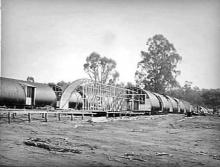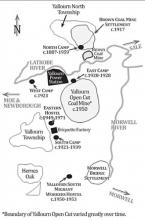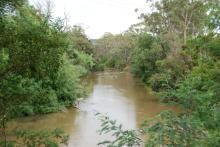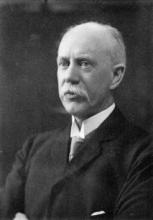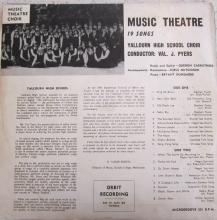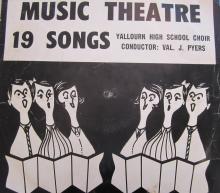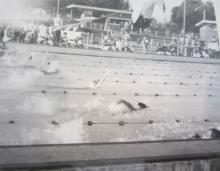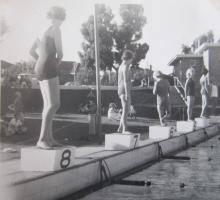PROBLEMS OF POLLUTION AT YALLOURN
Those readers of this article, who lived in Yallourn, will fully appreciate the problems caused by coal dust, from the Open Cut and the briquette factory, when carried across the township by the wind.
Dust and smoke are not unusual or unexpected in mining towns but the large volumes of airborne coal dust in Yallourn were a genuine problem. The fine-grained coal dust particles were highly combustible and the fear of house fires was always present.
Non-residents of Yallourn were/are often surprised to hear that the coal dust collected in the roof cavities, of the homes in Yallourn, to such a degree, that …
“…After the war, the SEC's regular maintenance included vacuuming the roof space of houses, in an effort to get rid of the coal dust that stored in the ceilings.” Source: Australian Heritage Commission. 2001 (written by Meredith Fletcher)
In an essay entitled ‘Renaissance in the Valley’, it is stated that the presence of airborne coal dust was so common that it caused an ailment of the eyes known as the ‘Yallourn squint’. This may be just part of ‘local folklore’ but on certain windy days, coal dust was extremely troublesome …
“Coal dust settled on everything. On the roof and in the ceiling. On washing on the line. Locals talked of ‘the Yallourn squint’, referring to how they walked around with eyes half closed against the dust from the mine and the ‘fly ash’ from huge smoke stacks.” Source: ‘The Age’ September 23rd 2007.
In the early years of the town, the levels of pollution of the Latrobe River, (emanating from the industrial works at Yallourn) were extreme. The following newspaper report outlines the consequences that coal dust had upon the water quality of the Latrobe River; and, in turn, the rural properties and towns downstream from Yallourn (e.g. Morwell, Glengarry, Flynn and Rosedale).
The article, which was published in June 1932, lists the names of local stakeholders who voiced their concerns about the parlous state of the Latrobe River.
As will be seen below, the water quality was, at one stage, described as a ‘river of ink’ by some members of the deputation, which met with Minister of Water Supply, Mr George Goudie.
JUNE 22ND 1932 ‘THE AGE’ PAGE: 11
POLLUTION OF LATROBE
RIVER.
"A STREAM OF INK."
Yallourn Works Blamed.
'A river of ink' was the description applied to the Latrobe River by speakers of a deputation which yesterday asked the Minister of Water Supply (Mr. Goudie M.L.C.) to take action to prevent the further pollution of the stream from the Electricity Commission’s works at Yallourn.
The deputation, which was introduced by Mr Hyland, M.L.A., was from a number of shires bordering on the river, and landholders in the district.
It was the outcome of a large public meeting held recently in Traralgon. The president of the Traralgon shire (Cr. K. Clarke) said in the early stages of the works at Yallourn the waste was poured into a lagoon. Now the lagoon was too small, and the coal dust and ashes went into the river.
The stream had never been large enough to carry flood waters, and now when the banks overflowed the black silt went with it, ruining pastures. Cattle would not cat the grass affected with this scum, and they would not drink the water from the stream. There was no doubt that sooner or later the stream would be corroded with the waste from the works.
Mr. J. S. Stockdale (Traralgon) said the pollution was first noticed about three years ago. Cattle would not drink the water, which was a heavy penalty on dairymen, but were forced to go to lagoons and drink water which became stagnant. This was likely to affect the quality of the butter.
Spring grasses were affected by the ashes and other refuse of an oily nature from the works that were washed over the banks of the stream.
When the flood waters went down, it looked as if the grass had been painted with some black substance. About 30,000 acres were affected in the Rosedale shire alone. If the pollution was continued it was possible the growth of the district would be affected.
Mr. A. P. Lindsay (Traralgon West) said three years ago his property was valued for the Morwell shire. A few months later, when a second valuation was made for another purpose, the same valuer reduced it £2 an acre because of the silt that had washed up on lo the pastures. It was mostly coal dust and oily waste from the Yallourn works. Before the works began there was no silt in the river.
FISH AFFECTED
Mr. E. Barbor (president, Gippsland Angling Association) said two years ago his association had taken up the question of pollution from the Yallourn works, believing that it would affect the fish in the stream. These fears were now realised. Six months ago about 90 keen anglers had visited the Latrobe, but all they got was one small fish and a bag of eels.
Although last year more people fished the stream than ever before, the results were poor. Yet above Yallourn, the Moe club had its best season. A few years ago, the Latrobe was a "beautiful golden stream." To-day it wound through the country "like a black snake. Fish were deserting it and going into other streams.
Cr. L. Hare (Morwell) said the Latrobe was now "like a river of ink." Recently a man who pumped water from the stream got about three gallons of oil from his tank. Before Yallourn started, the Latrobe was one of the best streams in Gippsland.
Mr. A. Burnett (Glengarry) said the waste came from the power house. A large quantity of material— tons of it every day— was being deposited in the river. It was accentuating the troubles of the dairymen at flooding periods.
Mr. McGregor, M.L.C., said he viewed with alarm the destruction of the Latrobe by the Yallourn works.
The Inspector of Fisheries and Game (Mr. Lewis) said he had interviewed officers of the Electricity Commission, and suggested that they build settling ponds to take the waste from the briquetting works. They had said they did not have the money for such work, he was concerned with keeping the streams pure in the interest of fishing.
The secretary of Traralgon shire (Mr. J. West) said the pollution of the Latrobe had destroyed the value of Sandbank Reserve, a picnicking resort near Traralgon
MINISTER'S REPLY
The Minister said he recognised the position was serious. "While the Water Commission had control of the streams as far as water supply was concerned, he thought those powers were limited concerning mining. There was a conflict of powers.
He thought the main source of pollution was the briquetting works. As these works were established some distance from the river, he could see no difficulty in the way of making settling ponds to carry the waste. If the pollution was caused by coal dust and ashes flying through the air and settling into the stream, that would be a much more difficult problem.
It seemed desirable to take the matter in hand before it got too bad. He viewed with alarm statements that pastures were being affected, also the pollution of the water to such an extent that residents and stock would not drink it.
He would go carefully into the matter, taking up with the Electricity Commission the question of doing something to remedy the menace.
FOOTNOTES
1. My apologies for any incorrect spelling of any names mentioned in the above article (as it was difficult to decipher certain paragraphs of the original article- Roger).
2. A reference regarding the expression ‘the Yallourn squint’ can be found in Meredith Fletcher’s book entitled ‘Digging People up for Coal’…
“Residents developed the Yallourn Squint to stop coal dust getting in their eyes…” Page: 82.
3. For younger readers, the source of the Latrobe River is to be found near Noojee on the Baw Baw Plateau on the Great Dividing Range; and the river flows eastwards to its mouth at Lake Wellington some 270 kilometres away.
4. In the early days, property owners downstream from Yallourn had often complained about the degradation of the water caused by coal dust and debris for the works. For example in the ‘Gippsland Times’ in 1931 …
“YALLOURN POLLUTION ….Cattle Driven From River… Landholders on the Latrobe River below Yallourn have decided to protest to the Electricity Commission against pollution of the stream by coal dust. Source: ‘Gippsland Times’ 9th February 1931.
5. Mr George Louie Goudie (1866-1949), (as mentioned above) was a remarkable character in the history of Victorian politics. He was elected to State Parliament in May 1919; and was member of Victorian Famers Union Party (better known as the Country Party in later years.) George Goudie…
“ …became a highly competent administrator, noted for his practical contributions to debates on rural issues. He chaired the Employment Council for six years and, in 1942, was appointed chairman of the Air Raids Precautions Shelters Committee. He was knighted in 1939.” Source: ‘ADB’ Volume 9. 1983.
6. Mr Hyland (1884-1970) M.L.A., as cited in the ‘The Age’ extract was knighted in 1952, Sir Herbert Hyland. Herbert was a member of the Victorian Parliament from 1929-1970 and was the leader of the Country Party from 1964-1970. He was the Member for Gippsland South for forty years and was the Chairman of the Latrobe Valley Development Advisory committee from 1949-53.
7. At the age of 86 years, Sir Herbert Hyland’s made the news again…
“Bert Hyland retained Gippsland South at fifteen consecutive elections—five of them unopposed. His personal popularity can be gauged by his last election (1967) when he secured the largest majority of any member of the Legislative Assembly. Having decided, at the age of 86, not to contest the 1970 election, he surprised the supervisor of the parliamentary dining-room Elsie Joan Mendoza, née Atkins, a 48-year-old divorcee, by asking her to be his wife.” Source: ‘ADB’ Volume 14-1996.
8. Sir Herbert Hyland died at Prahran, on the 18th March 1970; and was given a state funeral in honour of his service to Victoria.
9. Mr McGregor MLC, (see above), was the Member for Gippsland Province (Upper House) from 1922 until 1936. Martin Robert McGregor (born: 1859), a farmer from Narracan, was a member of the National Party and later the United Australia Party.
10. Among other things, Mr McGregor was the President of the Narracan Shire Council for several terms and was a director of the Trafalgar Co-operative Butter Factory. He was also the chairman of the Trafalgar Water Trust from 1926-36.
11. A repudiation, of the cause pollution of the waters of the Latrobe River, was advanced by certain (unnamed) officials of the SECV early in 1931...
“Officials at Yallourn Electricity Works deny that the pollution of Latrobe River was due to coal dust from the briquetting works. Tests above and below the weir showed the same amount of sediment, which was harm less to human beings, vegetation or stock. It was reported that two coal seams that cross the stream between Traralgon and Yallourn were the real causes.” Source: ‘Gippsland Times’ February 16th 1931.
12. In an article, related to the use of coal dust as a potential fuel for locomotives, the ‘Gippsland Times’ reported on the use of electrostatic precipitators at Yallourn to capture the particles of coal and prevent air-borne emissions…
“…for use from the chimney stacks of the briquette plant at Yallourn. It 'is collected in' them- by electrically 'charged grids, known' as electrostatic precipitators, which attract and hold the fine particles of coal dust. The dust can then be used, 'without further treatment; as fuel in locomotives equipped with special equipment to burn it.” Source: ‘Gippsland Times’ April 28th 1952.
13. Some readers may remember Mr Archie Robertson (who resided at Ridgeway Avenue).Mr Robertson, who came to Australia from Scotland, was a popular and highly respected English teacher at the Yallourn Technical School teacher. He taught at Yallourn TS for twenty-two years before transferring to Aspendale Technical School in 1962. Sometime, during those years at Yallourn, Mr Robertson wrote a four-line poem about coal dust which was later re-published in Prue McGoldrick’s book in 1984…
‘’Yallourn’s a modern town,
But too far from the city,
The coaldust gets us down
And leaves our laundry gritty.”
---------------------------------------------------------------------------------------------------
This story is part of a history project entitled ‘From the Newspapers’ and a full list of titles in this series can be obtained by contacting Julie George. The research and writing of this article were completed by Roger Spaull and presented and posted by Julie George for the Virtual Yallourn website in September 2018.
The above extract from the ‘The Age’ has been faithfully reproduced. The only amendments to the original copy are the font style, font size and spacing, so as to enhance the story for the purposes of posting on the Virtual Yallourn website.

